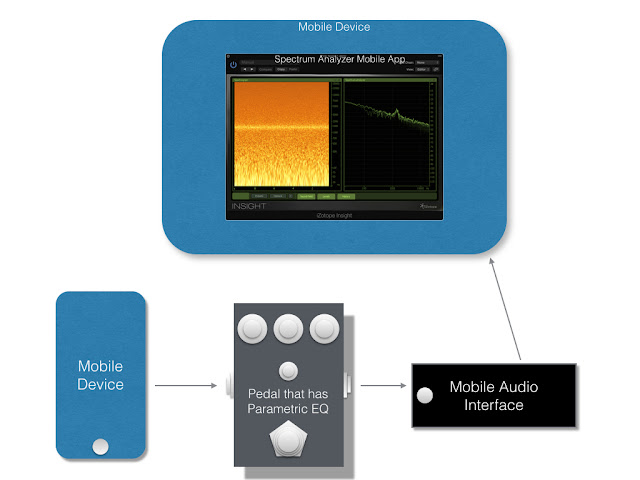Intro
I am an unabashed fan of so-called "djent" Metal. Actually, I enjoy many genres of music, and "djent" has been especially interesting the past few years. (Misha "Bulb" Mansoor of Periphery was the popularizer of the word "djent".) The style can be roughly characterized as: heavy, progressive--often complex, even groove-centric--Metal that maintains a very tight feel.
Extraordinary Djentlmen
Check out Periphery's latest double album, "Juggernaut: Alpha" and "Juggernaut: Omega", for some intense, poly-rhythmic, nuanced, and ridiculously tasteful and dynamic Metal.The SEQret Sauce
The most complete and helpful guide I've come across for achieving djent-like tone is "Guide to Djent Tone" on the Gilks site. What is the secret sauce of djent? EQ. What kind of equalization? Parametric. Specifically, a bump at 1.4 kHz (1400 Hz) brings out a nice djenty flavor. The more you bump it, the more gnarly it sounds. Too far, and it will sound nasal-y and not very usable.Getting Started
Where do we start? First, find an effects pedal that contains a parametric EQ. It does not need to be a distortion pedal. It just needs to have a parametric EQ onboard. I scoured the Web (and Sweetwater) for possibilities, and the most cost-effective for me was the DOD Boneshaker pedal. Even though it comes with distortion, I only care about the parametric EQ capability. I keep its distortion knob at zero.Next--if possible--play a loop of pink noise through your new djent-tone-making parametric EQ-capable pedal, adjusting the hi-Mids until you're able to isolate 1.4kHz (1400 Hz) and notch it up. The reason parametric EQ is desirable is because it is sweepable. The DOD Boneshaker required using the stacked "High" knobs to dial in 1.4kHz. The "Mid" knobs adjusted frequencies significantly lower than 1.4kHz, which was a little surprising. (Learn something new every day.)
Finally, once you've dialed it in, you'll be pleased by the results when you start jamming.
How To Djent-Q
Here is a basic how-to guide for figuring out how to dial in the magic 1.4kHz. Hopefully, these pictures and diagrams will help you, or at least give you ideas how you can achieve a similar result.Here is a list of what you'll use. All of these are discussed below:
- A Windows or Mac PC
- A mobile device capable of playing back audio
- A cable with 1/8" jack on one end, and 1/4" on the other
- And your newly-acquired (heretofore referred to as) "Djent-Q" pedal
- Your instrument (if you forgo the whole pink noise approach)
Pink Noise
The Easy Way (Mobile App)
I used a mobile App called AudioTools to generate pink noise straight into my "Djent-Q" pedal. However, you don't need to buy an App to do this. You can generate pink noise for free (see further below).
The icon to launch AudioTools, which I used for generating pink noise.
The generator in AudioTools. Notice I selected "Pink" noise. To play the noise, I needed to also click the "Mute" button in the lower right to un-mute the sound (muted by default).
Pink Noise
The FREE Way!!!!!!!!!!!!11 (using a PC)
You can download Audacity audio editing app and generate a pink noise sound loop that way. Here's how. Audacity is available for Mac and Windows, and it is completely free.
Download, install, and launch Audacity
From the Audacity menu, choose Generate > Noise...
Choose "Pink" from the Noise type list.
This will generate a 30 second clip of pink noise.
From the Audacity menu, choose File > Export...
I named the audio file "Pink Noise" and put it in the Music folder.
I recommend saving the file in an uncompressed format, e.g., WAV (Windows) or AIFF (Mac).
Now load that audio file onto your mobile device so you can play it into your Djent-Q pedal. If you already own a mobile App that can generate pink noise, then skip this whole "The Free Way!!1" section.
Making Connections
You will need to connect your mobile device to the Djent-Q pedal. I recommend the following type of cable (pictured). I believe I bought mine at Guitar Center, though I'm sure Best Buy, and other tech-related stores, carry this kind of cable. It has a stereo 1/8" jack on one end (for your mobile device), and a mono 1/4" jack on the other end (to plug into the "IN" of your new Djent-Q pedal).
1/8" stereo jack on one end, and 1/4" mono jack on the other end. If you can't find 1/8" stereo, then use 1/8" mono.
Spectrum Analyzer
There are free spectrum analyzer apps, such as iSpectrum for Mac. You'll want to use one that can analyze audio in real-time, if possible.
Free
iSpectrum for Mac. Takes the input of your USB/Firewire/Thunderbolt audio interface and displays the sonic spectrum information in real-time.
Not Free
EQ Method #1
Mobile Device -> Djent-Q pedal -> Audio Interface -> PC (or 2nd mobile device)
Play the pink noise sound into your Djent-Q pedal, through your audio interface, and finally into your spectrum analyzer app.
I kept adjusting the "High" knobs of my Boneshaker (aka "Djent-Q") pedal until I found the magic 1.4kHz. Notice the exaggerated frequency bump at 1400 Hz on the Spectrum Analyzer App in the examples above.
EQ Method #2
Instrument -> Djent-Q pedal -> Audio Interface -> PC (or 2nd mobile device)
This method is less technical, but can yield good results, too. The reason the pink noise method is easier is because pink noise is evenly-distrubuted across the entire sonic spectrum. Your instrument, on the other hand, will have its own sonic peaks and valleys, so it will be a little harder to "see" the bump at 1.4kHz when you find it.
The Boneshaker
Below is a picture of how I adjusted the DOD Boneshaker pedal to find the magic 1.4kHz. Notice the specific adjustments to the "High" knobs. Also notice that I am not using the Distortion feature at all. I am relying on my Tech 21 Character Series pedals for gain and crunch.







